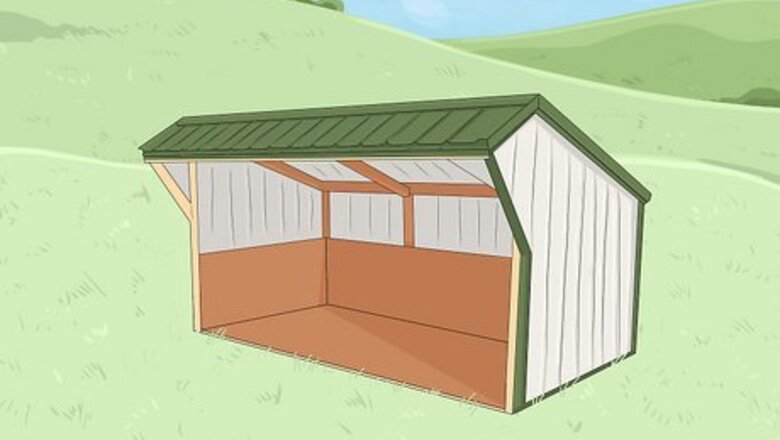
views
Providing the Right Environment
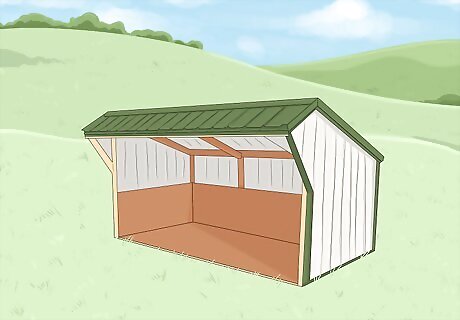
Provide year-round shelter. Your sheep need a shelter that protects them from all the elements, year round. These elements include sun, wind, and rain. While a barn is a great, it's not necessary. A three-sided structure works just as well. The nice thing about having a barn with stalls is that you can separate sick or pregnant sheep from the rest of the flock. A shaded area outside is a good idea, so that the sheep can be outside in the warm weather, but have somewhere cool to graze. This could be anything from an overhang off the barn, or a clump of trees.
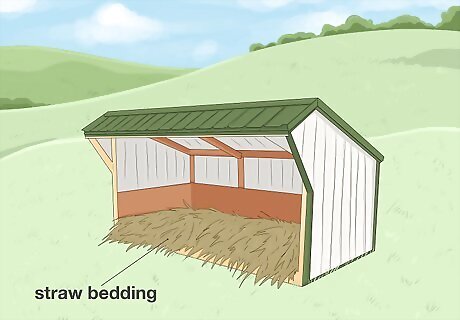
Give them straw bedding. How much bedding you have should depend on how much time the sheep spend in their shelter. For colder climates it's best to give them a good, thick bedding of hay. This will keep them clean and warm. You shouldn't use sawdust for wool sheep as this will ruin their wool. Some people consider pine shavings to be better than hay, because of its absorbency, but that simply depends on your personal preference. Pine shavings do cling to a sheep's coat, which can make it more difficult come shearing time. You can sprinkle PDZ in each stall and under the overhang outside about once a month to neutralize urine.

Make sure that your pasture supports the number of sheep you choose. Sheep will spend about 7 hours a day grazing. Most estimates are about 10 sheep per acre. The number can vary based on size and condition of sheep (ewes with lambs), condition of pasture (tall fescue grows fast spring and fall), and how you manage your pasture. Pasture sizes vary based on locale, climate, maintenance, type of planting, and rainfall. For example: dry rocky conditions will need more pastureland to provide more grass. EXPERT TIP Liz Riffle Liz Riffle Regenerative Farming & Agriculture Specialist Liz Riffle is a Regenerative Farming & Agriculture Specialist and the Owner of Riffle Farm in West Virginia. With over six years of experience, Liz specializes in holistic bison farming and employing humane agricultural practices in her business. Riffle Farm is the first commercial bison operation in the state of West Virginia and is part of the movement to facilitate the large-scale regeneration of the world’s grasslands. Liz is a Savory Accredited Professional and teaches Holistic Management across the country. She received her Masters in Nursing Education from Excelsior University and was part of the US Navy Nurse Corps Commission at Northwestern University. Liz Riffle Liz Riffle Regenerative Farming & Agriculture Specialist Rotating livestock to new pastures every 6 days controls parasites. Taking good care of livestock means understanding how parasites live and spread. It's important to move animals to new pastures every 6 days or so. This helps stop parasites from hatching and reinfecting the animals. Animals should not go back to the same pasture for 3 whole weeks to break the cycle. Rotating pastures this way is a more natural way to control parasites without using strong medicine.

Keep the airflow moving. Install a fan, and keep the doors to the shelter open. This is especially important if you live in a hotter climate, or have hot summers. There should be airflow all throughout the year, even in the cooler times, although you don't necessarily want to have the fan going in winter. A fan and open doors will cool the shelter on hot days, as well as keep the flies away from the sheep.

Set up fencing. Fencing is incredibly important for keeping the sheep in and the predators out. A five foot (1.5 m) tall fence should be enough to keep the sheep in the pasture. Higher fences are needed to keep predators out. Make sure you have portable panels to enclose sick sheep, especially if you're also got stalls. You'll need to keep them away from the healthy sheep. You can also electrify your fence. Even with a tall seven foot (2 m) tall fence, predators can dig under the fence and attack your sheep. Electrifying your fence will deter predators as soon as they touch the fence. Don't count on it keeping your sheep in, though. With heavy coats, sheep are less likely to feel the bolts of electricity.
Feeding Your Sheep
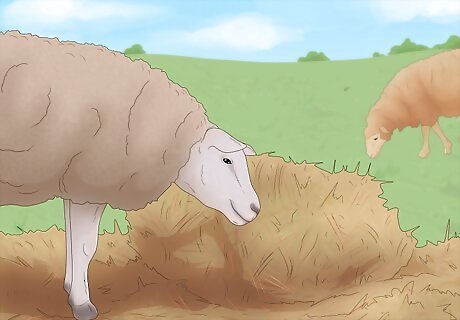
Have pasture or hay make up most of their diet. Sheep naturally eat pasture plants such as grass and clover. If the pasture is large enough and stays in bloom all year, you do not need to provide supplemental food for the sheep. The amount of hay needed will depend on the quality of the hay, use of pasture, condition of sheep (pregnant ewes, or with lambs) and amount of grain being feed. A reasonable estimate for feeding strictly hay is about 3.5 percent body weight per day. Hay is basically cut, dried, and baled forage. It tends to be a grass or legume (like alfalfa or clover). The later the cutting the better the feed quality of the hay, typically. Alfalfa and clover hays tend to be more nutritious and preferred by most animals. They are more expensive, though, and aren’t imperative for sheep. Keep in mind that some clovers may contain a substance similar to estrogen which can work as birth-control in sheep, so avoid that if you’re trying to breed your ewes.

Avoid over-feeding your sheep grain. Grain isn't actually that great for sheep, except in a few specific cases, because these mixes tend to contain too much copper for a sheep's diet. If you do need to supplement your sheep's diet with grain try to get a mix that is specially formulated for sheep. Eating too much grain can also cause your sheep to bloat, and potentially die. So really avoid over-feeding grain. A basic mix with corn/soy/oats, or specially formulated sheep/goat chow from your local feed mill should work if they need a little extra supplement. Ones that may need some grain added to their diet typically are young, lactating, or elderly sheep. Goat or cow mixes are better than horse mixes if you can’t find one that is formulated specially for sheep. Again, sheep are sensitive to copper, so avoid all-purpose mixes.
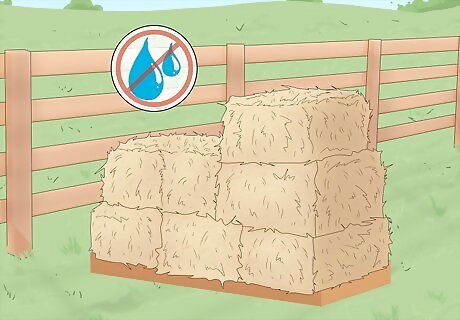
Store food. Hay should be dry before being stored, kept out the rain, and off the ground. If hay gets damp it can be dried again and used for bedding; though care needs to be taken to prevent sheep from eating molded hay. Grain should be stored in metal containers with lids to prevent damage from rodents.

Make sure your sheep have access to salt. Sheep need the minerals that come with salt. Make sure that you're getting minerals that are specially made for goats, because while they need copper too much copper can make them ill or kill them. Salt blocks can be good, but they also don't last all that long and might not get enough minerals just from licking it. Loose mineral salt tends to be less expensive than salt blocks and you can place it in a feeder in the shelter.
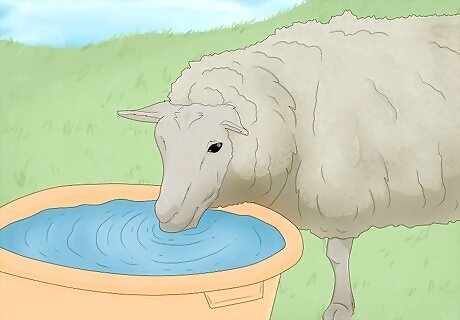
Provide them with fresh, clean water. Sheep need access to fresh, clean water. Sheep will consume a couple gallons of water each day, and more when it is hot and it needs to be clean (free of algae and so on). You can use an automatic waterer if you don't want to have to carry a bunch of buckets every day. The tub automatically fills when the animals drink. All you have to do is scrub it clean once a week.
Keeping Your Sheep Healthy
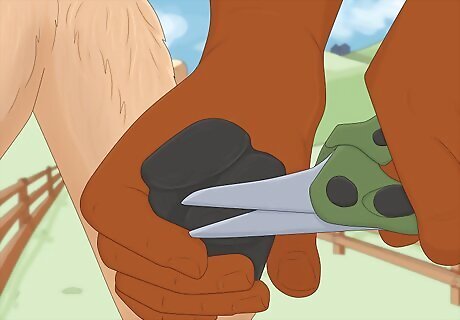
Maintain their hooves properly. You want to provide a dry surface for your sheep to walk on the majority of the time and helps to avoid things like foot rot. If it isn't possible for your sheep to spend time on dry surfaces you'll need to cut or pare away any excess horn (which is what their hooves are made out of). Make sure that when you do cut at the dead horn that you don't cut deep into sensitive tissue. This can cause bleeding and infection in the sheep. In dry weather you want to trim their hooves every six weeks or so, more in wet weather. Start by digging out dirt from the toes. Trim away excess nail parallel to the lines of hoof growth. Pare the heels to the same level as the soles of the toes. Take away excess nail tissue around each toe. With a wood rasp, make the hoof flat from the sole of the foot forward. Foot rot is a problem specific to sheep and goats. It's more frequent with animals who walk on damp or wet ground. Their hooves soften which makes it easier for bacteria to get in. Foot rot can cause severe pain and lameness and usually stays in the pasture around 12 days. Separate infected sheep from the flock (you'll notice a foul smell). Pare the hoof to remove excess horn, and apply antiseptic agents.
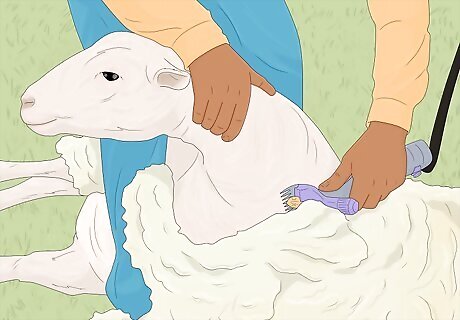
Shear them at least once a year. Sheep with longer fleeces will need to be sheared twice a year. Consider shearing your sheep before the onset of warmer weather and avoid shearing before cold weather. You want your sheep to be comfortable during the shearing, so keep your sheep off the pasture for at least ten hours before shearing. This will allow their stomachs to empty out. Shearing wet sheep can cause health problems, so avoid doing that. Not shearing sheep and allowing their fleece to get waterlogged can make them more prone to flystrike.

Perform preventative health care. While you can't anticipate everything that might happen to a sheep (know your local veterinarian), there are some things you can do to care for your sheep. Performing these extra steps can help keep the sheep from certain sicknesses and problems. Crutching means trimming the wool around the crutch of the sheep (the area immediately around and below the tail, down the hind legs and halfway to the underside of the body). Urine and feces can soil this area, so keeping it clean can prevent things like flystrike. Dagging removes all the dirty wool around the rear end and belly of your sheep. Dags are basically the clumps of soft or hard fecal (or mud) material that's become bound into the wool of the sheep. Dags can attract blowflies, so try to remove the dags as soon as possible while they're still soft and the blowflies haven't found them yet. Use hand shears or digging shears.

Keep an eye on general health. You'll know when your sheep is sick, basically they'll be doing things that are unusual or lethargic, and so on. Keeping an eye on their basic health can alert you to problems more quickly so that it doesn't spread to the rest of the flock. A nasal discharge may be one of the first signs of a respiratory infection. Diarrhea in sheep is about the consistency of dog stool. Diarrhea can be caused by all manner of issues, so it's a good thing to get a veterinarian in quickly. Check the coat frequently for any external parasites such as mites or lice. They'll need to be treated immediately.
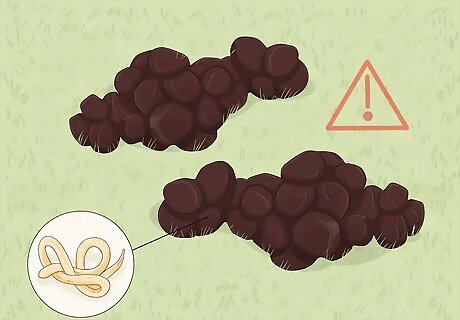
De-worm your sheep. You'll need to have your veterinarian occasionally check your sheep's stool to see if they have worms. If they do you'll need to rotate between ivermectin with fenbendazole or albendazole. No one product will destroy all types of parasites, unfortunately, so you should seek your veterinarian's help in determining what will be best for your sheep. Medication (dewormers) come in types: bolus (large pill), paste, liquid, pour on, and injectable. There is no one type that works most effectively. Paste or liquid forms tend to be the easiest to use, but otherwise are no more effective than any other type.




















Comments
0 comment